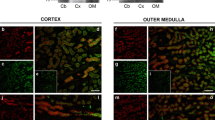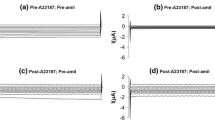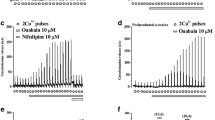Abstract
The effects of bradykinin (BK) and histamine (Hist) on the membrane voltage (V m), ion conductances and ion channels of cultured human glomerular epithelial cells (hGEC) were examined with the nystatin patch clamp technique. Cells were studied between passage 3 and 20 in a bath rinsed with Ringer-like solution at 37°C. The mean value of V m was −41±0.5 mV (n=189). BK (10−6 mol/l, n=29) and Hist (10−5 mol/l, n= 55) induced a rapid transient hyperpolarization by 15±1 mV and 18±1 mV, respectively. The hyperpolarization was followed by a long lasting depolarization by 6±1 mV (BK 10−6 mol/l) and 7±1 mV (Hist 10−5 mol/l). The ED50 was about 5×10−8 mol/l for BK and 5×10−7 mol/l for Hist. In the presence of both agonists, increases of outward and inward currents were observed. A change in the extracellular K+ concentration from 3.6 to 30 mmol/l depolarized V m by 8±1 mV and completely inhibited the hyperpolarizing effect of both agents (n=11). Reduction of extracellular Cl− concentration from 145 to 30 mmol/l led to a depolarization by 2 ±1 mV (n=25). In 30 mmol/l Cl− the depolarizations induced by BK (10−7 mol/l) and Hist (10−6 mol/l) were augmented to 9±2 mV (n=14) and to 10±2 mV (n=11), respectively. Ba2+ (5 mmol/l) depolarized V m by 19±5 mV (n=6) and completely inhibited the hyperpolarization induced by BK (10−6 mol/l, n=3) and reduced that of Hist (10−5 mol/l) markedly (n=3). Preincubation with the K+ channel blocker charybdotoxin (1–10 nmol/l) for 3 min had no significant effect on V m, but reduced markedly the BK(10−6 mol/l, n=11) and Hist-(10−5 mol/l, n=6) induced hyperpolarizations. In 10 out of 31 experiments in the cell attached nystatin patch configuration big K+ channels with a conductance \((g_{K^ + } )\) of 247±17 pS were found. The open probability of these K+ channels was increased 3- to 5-fold during the hyperpolarization induced by BK (10−7 mol/l) or Hist (10−5 mol/l, both n= 4). In excised inside/out patches this K+ channel had a mean conductance of 136±8.5 pS (n=10, clamp voltage 0 mV). The channel was outwardly rectifying and its open probability was increased when Ca2+ on the cytosolic side was greater than 0.1 μmol/l. The data indicate that BK and Hist activate a \((g_{K^ + } )\) and a \(g_{Cl^ - } \) in hGEC. The hyperpolarization is induced by the activation of a Ca2+-dependent maxi K+ channel.
Similar content being viewed by others
References
Bascands JL, Emond C, Pecher C, Regoli D, Girolami JP (1991) Bradykinin stimulates production of inositol (1,4,5) triphosphate in cultured mesangial cells of the rat via a BK2- kinin receptor. Br J Pharmacol 102:962–966
Beavan MA (1982) Factors regulating availability of histamine at tissue receptors. In: Ganellin CR, Parson ME (eds) Pharmacology of histamine receptors. Wright, Bristol, pp 103–145
Bross KJ, Pangalis PA, Staatz CG, Blume KG (1978) Demonstration of cell surface antigens and their antibodies by the peroxidase-antiperoxidase method. Transplantation 25:331–334
Carmines P, Fleming JT (1990) Control of the renal microvasculature by vasoactive peptides. FASEB J 4:3300–3309
Cybulsky AV, Bonventre JV, Quigg RJ, Wolfe LS, Salant DJ (1990) Extracellular matrix regulates proliferation and phospholipid turnover in glomerular epithelial cells. Am J Physiol 259:F326-F337
Delarue F, Virone A, Hagege J, Lacave R, Peraldi M-N, Adida C, Rondeau E, Feuteun J, Sraer J -D (1991) Stable cell line of T-SV40 immortalized human glomerular visceral epithelial cells. Kidney Int 40:906–912
Dworkin LD, Iekuni I, Brenner BM (1983) Hormonal modulation of glomerular function. Am J Physiol 244:F95-F104
Estacion M (1991) Acute electrophysiological responses of bradykinin-stimulated human fibroblasts. J Physiol (Lond) 436:603–620
Gilbert SF, Migeon R (1975) D-Valine as a selective agent for normal human and rodent epithelial cells in culture. Cell 5:11–17
Gögelein H, Greger R, Schlatter E (1987) Potassium channels in the basolateral membrane of the rectal gland of Squalus acanthias. Regulation and inhibitors. Pflügers Arch 401: 107–113
Greger R, Kunzelmann K (1991) Simultaneous recording of the cell membrane potential and properties of the cell attached membrane of HT29 colon carcinoma and CF-PAC cells. Pflügers Arch 419:209–211
Gröne HJ, Walli AK, Gröne E, Krämer A, Clemens MR, Seidel D (1990) Receptor mediated uptake of apo E and apo B rich lipoproteins by human glomerular epithelial cells. Kidney Int 37:1449–1459
Hayslett JP, Gögelein H, Kunzelmann K, Greger R (1987) Characteristics of apical chloride channels in human colon cells (HT29). Pflügers Arch 410:487–494
Holthöfer H, Saino K, Miettinen P (1991) Rat glomerular cells do not express podocytic markers when cultured in vitro. Lab Invest 65:548–557
Karnushina IL, Palacios JM, Barbin G, Dux E, Joo F, Schwartz JC (1980) Studies on a capillary rich fraction isolated from brain: histamine components and characterization of the histamine receptors linked to adenylate cyclase. J Neurochem 34:1201–1208
Kolb HA (1990) Potassium channels in excitable and non-excitable cells. Rev Physiol Biochem Pharmacol 115:51–140
Kreisberg JI, Karnovsky MJ (1983) Glomerular cells in culture. Kidney Int 23:439–447
Kremer S, Harper P, Hegele R, Skorecki K (1987) Bradykinin stimulates a rise in cytosolic calcium in renal glomerular mesangial cells via a pertussis toxin insensitive pathway. Can J Physiol Pharmacol 66:43–48
Lang F, Friedrich F, Paulmichl M, Schobersberger W, Jungwirth A, Ritter M, Steidl M, Weiss H, Wöll E, Tschernko E, Paulmichl R, Hallbrucker C (1990) Ion channels in Mardin-Darby canine kidney cells. Renal Physiol Biochem 13:82–93
Marsden PA, Brock TA, Ballermann BJ (1990) Glomerular endothelial cells respond to calcium mobilizing agonists with release of EDRF. Am J Physiol 258:F1295-F1303
Marty A, Finkelstein A (1975) Pores formed in lipid bilayer membranes by nystatin. J Gen Physiol 65:315–326
Mehrkle G, Pohl U, Daut J (1991) Effects of vasoactive agonists on the membrane potential of cultured bovine aortic and guinea-pig coronary endothelium. J Physiol (Lond) 439:277–299
Miller C, Moczydlowski E, Latorre R, Philipps M (1985) Charybdotoxin a protein inhibitor of single Ca2+ activated K+ channels from mammalian skeletal muscle. Nature 313:316–318
Miller C, Latorre R, Reisin I (1987) Coupling of voltage-de-pendent gating and Ba2+ block in the high-conductance, Ca2+-activated K+-channel. J Gen Physiol 90:427–449
Pavenstädt H, Späth M, Fiedler C, Fischer R, Schlunck G, Wanner C, Schollmeyer P (1992) Effect of bradykinin on the cytosolic calcium activity and phosphoinositol turnover in human glomerular epithelial cells. Renal Physiol Biochem 15:277–288
Pavenstädt H, Späth M, Schlunck G, Nauck M, Fischer R, Wanner C, Schollmeyer P (1992) Effect of nucleotides on the cytosolic free calcium activity and inositol phosphate formation in human glomerular epithelial cell. Br J Pharmacol 107:189–195
Peres A, Racca C, Zippel R, Sturani E (1990) Cytosolic calcium and membrane conductance in response to platelet-derived growth factor and bradykinin stimulation in single human fibroblasts. Eur J Cell Biol 53:290–295
Pfeilschifter J (1989) Cellular signalling in the kidney. The role of inositol lipids. Renal Physiol Biochem 12:1–31
Sauve R, Simoneau C, Parent L, Monette R, Roy G (1987) Oscillatory activation of calcium dependent K+ channels in HeLa cells induced by histamine H1 receptor stimulation: a single channel study. J Membr Biol 96:199–208
Sauve R, Chahine M, Tremblay J, Hamet P (1990) Single channel analysis of the electric response of bovine aortic endothelial cells to bradykinin stimulation: contribution of a Ca2+ dependent K+ channel. J Hypertens 7:S193-S201
Sedor JR, Abboud HE (1984) Histamine receptors in isolated human glomeruli. Kidney Int 26:144–152
Sedor JR, Abboud HE (1985) Histamine modulates contraction and cyclic nucleotides in cultured rat mesangial cells. Differential effects mediated by histamine H1 and H2 receptors. J Clin Invest 75:1679–1685
Wiemer G, Scholkens BA, Becker RH, Busse R (1991) Ramiprilat enhances endothelial autacoid formation by inhibiting breakdown of endothelium-derived bradykinin. Hypertension 18:558–563
Xiong W, Chao L, Chao J (1989) Renal kallikrein mRNA localization by in situ hybridization. Kidney Int 35:1324–1329
Author information
Authors and Affiliations
Rights and permissions
About this article
Cite this article
Pavenstädt, H., Bengen, F., Späth, M. et al. Effect of bradykinin and histamine on the membrane voltage, ion conductances and ion channels of human glomerular epithelial cells (hGEC) in culture. Pflugers Arch. 424, 137–144 (1993). https://doi.org/10.1007/BF00374604
Received:
Revised:
Accepted:
Issue Date:
DOI: https://doi.org/10.1007/BF00374604




